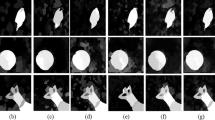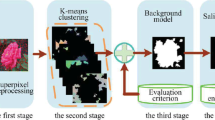Abstract
Humans possess an intelligent system which effortlessly detect salient objects with high accuracy in real-time. It is a challenge to develop a computational model which can mimic human behavior such that the model achieves better detection accuracy and takes less computation time. So far the research community have suggested models which achieve better detection accuracy but at the cost of computation time and vice versa. In this paper, we attempted to realize a model that takes less computational time and simultaneously achieves higher detection accuracy. In the proposed model the original image is divided into m superpixels using SLIC superpixels algorithm and then these superpixels are clustered into k regions using k-means algorithm. Thereafter the result of the k-means clustering is used to build Gaussian mixture model whose parameters are refined using Expectation-Maximization algorithm. Finally the spatial variance of the clusters is computed and a center-weighted saliency map is computed. The performance of the proposed model and seventeen related models is evaluated both qualitatively and quantitatively on seven publicly available datasets. Experimental results show that the proposed model outperforms the existing models in terms of precision, recall and F -measure on all the seven datasets and in terms of area under curve on four datasets. Also, the proposed model takes less computation time in comparison to many methods.







Similar content being viewed by others
References
Achanta R, Susstrunk S (2010) Saliency Detection using Maximum Symmetric Surround. Proc. International Conference on Image Processing, pp. 2653–2656
Achanta R, Hemamiz S, Estraday F and Susstrunk S (2009) Frequency-tuned Salient Region Detection. Proc IEEE International Conference on Computer Vision and Pattern Recognition, pp. 1597–1604
Achanta R, Shaji A, Smith K, Lucchi A, Fua P, Susstrunk S (2010) SLIC Superpixels. EPFL Technical Report 2010:149–300
Arya R, Singh N, Agrawal RK A novel hybrid approach for salient object detection using local and global saliency in frequency domain. Multimedia Tools and Applications. doi:10.1007/s11042-015-2750-y
Borji A, Itti L (2013) State-of-the-art in visual attention modeling. Proc IEEE Trans Pattern Anal Mach Intell 35(1):185–207
Bruce NDB, Tsotsos JK (2006) Saliency based on information maximization. Proc Adv Neural Inf Proces Syst 18:155–162
Frintrop S, Rome E and Christensen HI (2010) Computational Visual Attention Systems and their Cognitive Foundation: A Survey. Proc. ACM Transactions on Applied Perception, Vol. 7, no. 1
Fu H, Cao X, and Tu Z (2013) Cluster-based co-saliency detection. IEEE Transactions on Image Processing, 2013.
Goferman S, Zelnik-Manor L, Tal A (2012) Context-aware saliency detection. Proc IEEE Trans Pattern Anal Mach Intell 34(2012):1915–1926
Han J, Ngan KN, Li MJ, Zhang HJ (2006) Unsupervised extraction of visual attention objects in color images. Proc IEEE Trans Circuits Syst Video Technol 16:141–145
Harel J, Koch C and Perona P (2007) Graph Based Visual Saliency. Proc. Advances in Neural Information and Processing Systems, pp. 545–552
Hou X and Zhang L (2007) Saliency Detection: A Spectral Residual Approach, Proc. IEEE Conference on Computer Vision and Pattern Recognition, pp. 1–8
İmamoğlu N, Lin W, Fang Y (2013) A saliency detection model using low-level features based on wavelet transform. Proc IEEE Trans Multimedia 15:96–105
Itti L, Koch C, Niebur E (1998) A model of saliency based visual attention for rapid scene analysis. Proc IEEE Trans Pattern Anal Mach Intell 20:1254–1259
Jiang, H., Wang, J., Yuan, Z., Wu, Y., Zheng, N. and Li, S., (2013). Salient object detection: A discriminative regional feature integration approach. In Proceedings of the IEEE conference on computer vision and pattern recognition (pp. 2083–2090).
Li, G. and Yu, Y., (2016). Deep contrast learning for salient object detection. In Proceedings of the IEEE Conference on Computer Vision and Pattern Recognition (pp. 478–487).
Li G, Yu Y (2016) Visual saliency detection based on multiscale deep CNN features. IEEE Trans Image Process 25(11):5012–5024
Lin, Y., Kong, S., Wang, D. and Zhuang, Y., (2014). Saliency detection within a deep convolutional architecture. In Workshops at the Twenty-Eighth AAAI Conference on Artificial Intelligence.
Liu T, Yuan Z, Sun-Wang J, Zheng N, Tang X, Shum HY (2011) Learning to detect a salient object. Proc IEEE Trans Pattern Anal Mach Intell 33:353–366
Liu Z, Shi R, Shen L, Xue Y, Ngan KN, Zhang Z (2012) Unsupervised salient object segmentation based on kernel density estimation and two-phase graph cut. Proc IEEE Trans Multimedia 14:1275–1289
Liu Z, Zou W, Meur OL (2014) Saliency tree: a novel saliency detection framework. IEEE Trans Image Process 23:1937–1952
Meur OL, Callet PL, Barba D, Thoreau D (2006) A coherent computational approach to model bottom up visual attention. Proc IEEE Trans Pattern Anal Mach Intell 28:802–817
Peng P, Shao L, Han J, Han J (2015) Saliency-aware image-to-class distances for image classification. Neurocomputing 166:337–345
Shen X, Wu Y (2012) A unified approach to salient object detection via low rank matrix recovery. Proc IEEE Conf Comput Vis Pattern Recognit 2012:853–860
Singh N, Agrawal RK (2013) Combination of Kullback–Leibler divergence and Manhattan distance measures to detect salient objects. SIViP 9(2015):427–435
Snowden RJ (2012) Visual attention to color: parvocellular guidance of attentional resources? Proc Psychol Sci 13:180–184
Vikram TN, Tscherepanow M, Wrede B (2012) A saliency map based on sampling an image into random rectangular regions of interest. Proc Pattern Recognit 45(9):3114–3124
Yang, C., Zhang, L., Lu, H., Ruan, X. and Yang, M.H., 2013. Saliency detection via graph-based manifold ranking. In Proceedings of the IEEE conference on computer vision and pattern recognition (pp. 3166–3173).
Yu Z, Wong HS (2007) A rule based technique for extraction of visual attention regions based on real time clustering. Proc IEEE Trans Multimedia 9:766–784
Zhang L, Tong MH, Marks TK, Shan H, Cottrell GW (2008) SUN: a Bayesian framework for saliency using natural statistics. Proc J Vis 8:1–20
Zhang W, Wu QMJ, Wang G, Yin H (2010) An adaptive computational model for salient object detection. IEEE Trans Multimedia 12:300–315
Zhang D, Han J, Han J, Shao L (2016) Cosaliency detection based on intrasaliency prior transfer and deep intersaliency mining. IEEE transactions on neural networks and learning systems 27(6):1163–1176
Zhao, R, Ouyang W, Li H, and Wang X (2015) "Saliency detection by multi-context deep learning." In Proceedings of the IEEE Conference on Computer Vision and Pattern Recognition, pp. 1265–1274
Zhu L, Klein DA, Frintrop S, Cao Z, Cremers AB (2014) A Multisize Superpixel approach for salient object detection based on multivariate normal distribution estimation. IEEE Trans Image Process 23:5094–5107
Author information
Authors and Affiliations
Corresponding author
Rights and permissions
About this article
Cite this article
Singh, N., Arya, R. & Agrawal, R.K. Performance enhancement of salient object detection using superpixel based Gaussian mixture model. Multimed Tools Appl 77, 8511–8529 (2018). https://doi.org/10.1007/s11042-017-4748-0
Received:
Revised:
Accepted:
Published:
Issue Date:
DOI: https://doi.org/10.1007/s11042-017-4748-0




